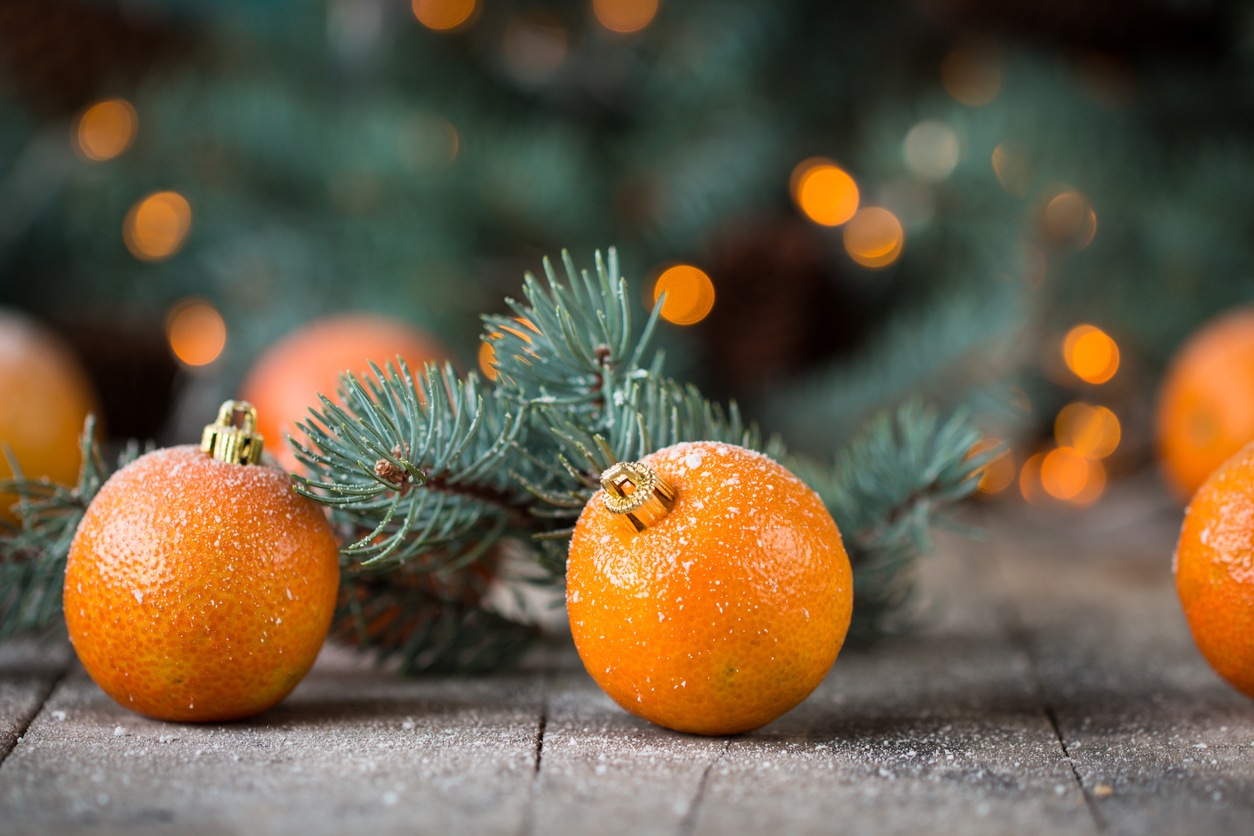Between the sleeting rain and chilly nights, it can be hard to remember that winter is still a “fruitful” time of year, so to speak. Each season, we wait patiently through the frost for that shining beacon of juicy winter deliciousness – CITRUS. And lo, the time has come for this year’s delicious arrivals to be enjoyed and celebrated!
Fun fact: did you know all citrus fruits can be traced back to a single ancestor? This great-great-great grandmother citrus tree originated in what was once a part of the Persian Empire, where it quickly diversified into several types of different citrus fruits, some of which we might recognize today and others which never managed to proliferate beyond Asia. The first evidence of citrus being grown in Europe dates to around the year 310 BCE, but there’s plenty of evidence showing that citrus had been cultivated for centuries back in Asia. A book written in 1178 AD by Chinese scholar Han Yen-chih describes and names around twenty-seven varieties of oranges alone, with additional descriptions of citrons, kumquats, and more; meanwhile, Europeans of the same era were limited to sweet orange, bitter orange (which was aptly named and used sparingly), lemon, and lime. To be fair, the average European noble in the Middle Ages might have scoffed at the idea of eating fresh fruit to begin with, viewing it as “unclean” and fit only for consumption by peasants. In fact, it was the Arabs who really popularized citrus in foods for the wealthy. Arabic culinary trends began to take a turn towards the sour sometime in the thirteenth century, and fruits like lemons and citron began appearing more often in wealthy kitchens – and cuisine.
Between the spread of ideas and goods via trades routes and the not-so-occasional invasions from certain Arabic armies, most of the citrus varieties we’re familiar with in the West had arrived by the 1400’s; however, certain citrus (such as the beloved mandarin orange) didn’t arrive until 1800’s, when trade routes and treaties were finally advanced enough to allow export to Europe and elsewhere. Double fun fact: did you know that Louis the Fourteenth of France had a collection of orange trees at the palace of Versailles? The palace already had an existing orangery, but Louis ordered that its size be doubled before filling the space with every orange tree he could get his hands on, including trees imported from countries all over the Mediterranean. All told, the orangery boasts around 1,000 orange trees total, all potted in tubs made of solid silver – talk about showing citrus some love!
While we might not have solid silver tubs, we’re showing citrus some love in our own Oliver’s way – check out some of the amazing citrus we have to offer this season. We invite you to try something new, whether in a cocktail, a sauce, a baked good, or enjoyed on its own. You may find a new favorite!
Buddha’s Hand Citron
While this citron may look like something out of a science fiction novel, it’s actually one of our very favorite citrus varieties. Unlike most citrus fruits, there’s neither pulp nor juice inside those funky fingers, just a whole lot of white pith; it’s the zest that’s the real gem on this citron, and there is a lot of it! Select one with ‘fingers’ that are clearly separated and curl slightly away from each other. The color should be bright yellow, the fruit should feel firm all over, and there should be a noticeable lemon-blossom scent.
Buddha’s Hand may not have the edible innards of its citrus cousins, but the sweetly scented zest is perfect for cooking, lending an incredibly delicate citrus flavor to any dish. Vinaigrettes, teas, and even infused liqueurs are perfect uses for Buddha’s Hand, but it’s shines especially bright when candied. Give the gift of citrus this holiday season with delicious Candied Buddha’s Hand that keep the sweetness going all year long!
Meyer Lemons
Let’s get one thing straight: Meyer Lemons are not conventional lemons; conventional lemons wish they could be half as tasty as Meyer Lemons. A cross between the famously sweet mandarin orange and the lemons most of us know, Meyer Lemons exemplify the best aspects of both. They’re noticeably smaller and darker in color than their conventional counterparts, looking more like an orange than a lemon, and the scent is closer to a bergamot and strangely complex. The flesh itself is far less acidic than an ordinary lemon and also far sweeter; this makes Meyers the ultimate lemon for baking with, as the flavor is far sweeter and more nuanced that conventional lemons.
While Meyer lemons are most often used in desserts, we think they’re the perfect choice for this flavorful Lemon Risotto! Enjoy it as a light side dish with big lemon flavor alongside grilled fish, roasted chicken, or seared steak.
Kumquats
These bite-sized citrus fruits are bursting with flavor! These little gems are completely edible, making them ideal for cooking and snacking alike. While Kumquats do contain a small amount of very tart juicy flesh, the real flavor lies in the skin; eaten whole, they offer an intense burst of citrus flavor with a tart, tangy finish. When selecting yours, opt for those that are bright orange and about 2 inches long; avoid kumquats with a green cast to the skin, as they are underripe!
Kumquats hold up well to cooking and are great for savory or sweet preparations. Slice them into coins to add to salads or homemade marmalade, or add to roasts and sauces for deliciously intense citrus flavor.
Satsuma Mandarins
Grown by family-owned and operated Tri-L Farms in Butte County, these Satsuma Mandarins are one of those special fruits we look forward to every year. Easy to peel and easier to eat, these Mandarins are super sweet and intensely aromatic. Look for oranges that are heavy for their size and have no tears in the peel, particularly where the stem once connected to the fruit.
Their intensely sweet flavor and easy-to-peel nature makes them terrific for snacking, but it also makes them a fantastic addition to a variety of cooked and baked items. We’ve used them in place of conventional oranges for a completely delicious version of the Christmas classic Duck a l’Orange. On the cocktail front, enjoy them in this epic Winter Citrus Mule using Stoli Vodka and ginger beer.
Pomelos
The largest of our featured citrus fruits, Pomelos are as big on sweetness as they are on size. Ranging in color from green to yellow and sometimes boasting a faint pink hue, the flesh will be white, yellow, or pink depending on the variety. A less bitter relative to Grapefruit, Pomelos have a sweet, acidic flavor, making them ideal for eating fresh – just peel and enjoy! Relatively new to the USA, Pomelos feature heavily in East and Southeast Asian cuisine, making them a great option for the adventurous home chef.
We love them juiced for cocktails and sauces, or cut into segments to use in salads or serve over ice cream! Try our Paloma with plenty of freshly squeezed juice and Casa Noble Tequila.
Ruby Red Grapefruit
Grapefruit is considered a superfood by many, and these gorgeous Ruby Red Grapefruit are no exception. Inside their unassuming yellow skin hides the ruby red flesh from which they get their name. The flavor is what we think of when we think of grapefruit: sweet and tart with just a hint of bitterness. In fact, the redder the flesh, the sweeter the grapefruit! Look for individuals that are highly aromatic and heavy for their size, with a blush of pink that indicates ideal ripeness.
Packed with Vitamin C, lycopene, and a whole host of other vital nutrients, Ruby Red Grapefruits make a great, healthy breakfast or snack all on their own, but they are also fantastic in more complex preparations. We love to mix the juice into cocktails for its bright color and flavor – try it in this amazing version of Hemingway’s Special Daiquiri.
Lemons & Pink Lemons
When life gives you lemons, make as many delicious dishes as you can! These incredibly versatile citrus fruits are a pantry essential for a reason – there’s practically nothing they don’t improve. Lemons are only very lightly sweet and are instead very acidic and intensely sour. Though the entire fruit is edible, the pith is very bitter and is typically not consumed; however, the zest is used frequently to up the pure lemon flavor in savory and sweet dishes alike. The pink variety (and yes, the flesh really is pink) are slightly sweeter and almost floral in their flavor. You can tell them apart by the green stripes that feature on the skin of the pink lemons! We like them in a Pink Lemon Rosemary Tom Collins.
Obviously, when given pink lemons, one makes pink lemonade, but these fruits overall are truly the most versatile of the bunch. Add fresh lemon juice to dishes for brightness and acidity, or add lemon zest for a bright top note of lemon flavor. Juice them for sauces, cakes, or cocktails, candy them, or just enjoy a fresh lemon wedge with almost any meal.
The world of citrus is full of possibilities, but we hope we have succeeded in curating a great selection of options to explore. We’re featuring the best of the best and invite you to pick up some favorites and make a new discovery, too! Our Produce Department team is also standing by, ready to answer your questions.


Comments
Add a commentI really liked the part of the citrus story of Louis the 14th making a citrus garden with silver planters. My old french tarot deck has a picture that I think is referring to this endeavor but I never understood what they were trying to show. As you learn more of world history, you are better able to read code in the analogs of that culture… good stuff here olivers. thanks.
Comment by Libby Hicks on November 10, 2021 at 12:07 pm